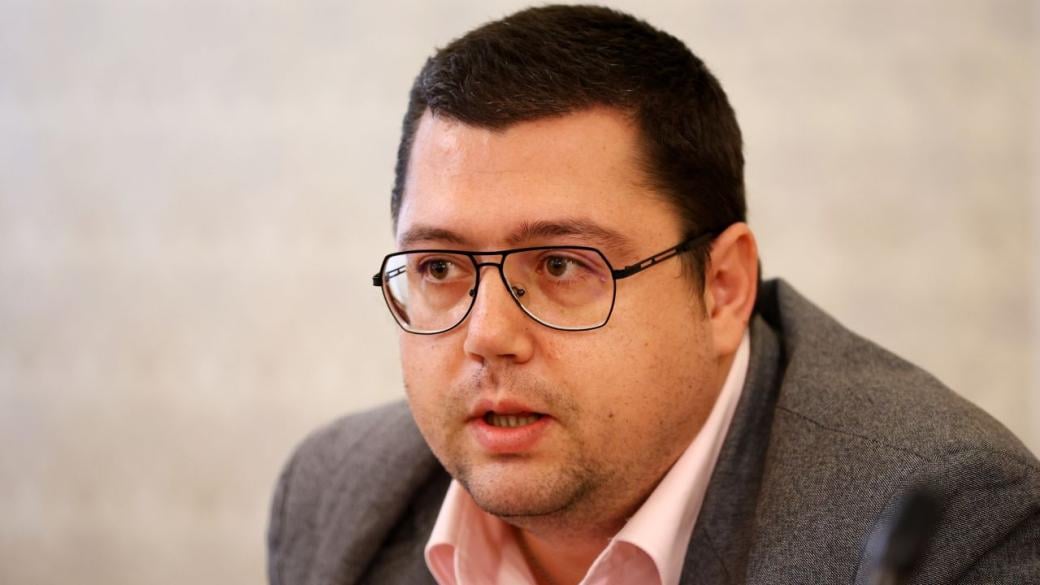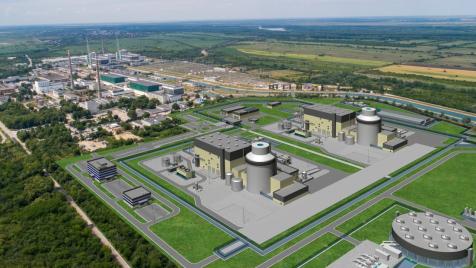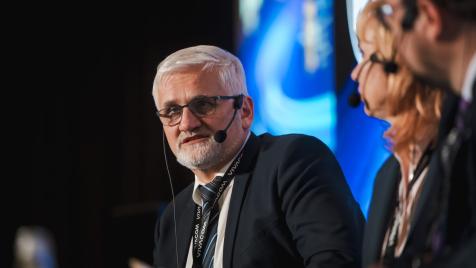Interview | Future data centers in Bulgaria must build their own energy capacity
We risk the Carbon border adjustment mechanism (CBAM) turning from an attempt to protect EU industry into yet another regulatory burden
Ivaylo Naydenov, Executive Director of BFIEC:

© ECONOMIC.BG / BTA
Ivaylo Naydenov holds a master's degree in Nuclear Energy and a doctorate in Nuclear Energy Installations and Equipment from the Technical University of Sofia. From 2014 to 2019, he held the academic positions of assistant and senior assistant in the Department of Thermal and Nuclear Energy at the Faculty of Power Engineering of the Technical University of Sofia.
He has completed short-term specializations in the field of energy security (NATO School in Antalya, Turkey, 2015, and Masaryk University School, Brno, Czech Republic, 2016) and critical raw materials (COST Action, Higher Technical Institute, Lisbon, Portugal, 2017), and has completed numerous training courses in the field of energy management, energy markets, and energy diplomacy. He won first place in the Bulgarian Nuclear Society's competition for best young scientist in 2017. He is an honorary lecturer at the University of National and World Economy (2018 – 2024) and at Sofia University St. Kliment Ohridski (since 2021). He has been the executive director of BFIEC since October 2019.
Mr. Naydenov, we are gathering on the stage of iN Sofia 2025 at a time when the world is literally redrawing the map of industry and energy – in a race that may prove to be the most decisive for our generation. While countries are fighting for factories, data, megawatts, and brains, where is Bulgaria in this sprint? Are we running shoulder to shoulder with the others, or are we still looking around at the starting line?
The most important task in Bulgaria from an industrial perspective is to preserve existing production in energy-intensive and other manufacturing industries. This will preserve the existing foundation on which new high value-added production facilities can be developed, including components, systems, and aggregates for zero-emission industries. Preserving energy-intensive industries will also have a positive impact on the retention and development of engineering personnel, who will undoubtedly be needed. Investments are also being made and innovations introduced in existing industries, many of which are related to decarbonisation and the introduction of artificial intelligence. These industries are also the foundation of the circular economy, as many of them are recycling industries.
When it comes to sprinting, we need to be clear about the goal we are sprinting towards and what we can realistically achieve, so that we don't end up like those likeable, exotic athletes who drop out in the qualifying rounds.
We should not approach the attraction of data centers haphazardly, just because it is fashionable and everyone is doing it. There must be a strategic approach in line with the country's capabilities. These computing "factories" are large consumers of electricity, and when attracting them, an analysis should be made of how their consumption will affect supply and prices for other consumers. A flexible approach, which is also the most realistic at the moment, is for these centers to build their own power generation facilities for their own needs. Given the construction time and the required production profile, gas-fired power plants would be the most suitable option.
In summary , we should preserve existing industries, create conditions to encourage investment and innovation, use the existing infrastructure to attract high value-added manufacturing, and, with regard to data centers, attract investment in an orderly and strategically thought-out manner.
Bulgaria really wants to attract energy-intensive investments, such as smart factories, data centers, and AI hubs, but is our current system and electricity grid ready to take on such a load?
Data centers in Bulgaria at the moment are like the old folk tale about the unborn Petko – more hypotheses are being built and grandiose scenarios are being drawn up, something we are not seeing for the first time in our country. Again, we should approach such investments in a more cool-headed and thoughtful manner. We should neither deny them nor imagine ourselves as the "computing center of the universe." Only after seeing the amount of consumption and the potential location of the sites can we comment on the need for investments in the transmission infrastructure, including the provision of backup power. The picture is similar with the construction of other new production facilities.
In my opinion, the potential addition of gigawatts of basic consumption would require additional investment in the electricity system. However, if potential investors in data centers build their own power sources, this would reduce the need for additional capital investment in the electricity transmission infrastructure, which, ultimately, is paid for by everyone. If such power plants are gas-fired, I believe that there is sufficient transmission capacity in the country's gas transmission system to provide fuel.
Adding new base or near-base consumption would also have positive effects because it would smooth out to some extent the relatively large differences that exist between maximum and minimum consumption in the country.
Assuming that energy is one of the main magnets for such investments, can we attract them?
From the point of view of the electricity balance, Bulgaria currently has sufficient available capacity, if we take into account the coal-fired power plants in the Maritsa basin, which operate at low capacity. Again, I emphasize that we do not know, at least publicly, what consumer capacity we are talking about, and are only building hypotheses. Bulgaria is well positioned in terms of connectivity and the degree of development of its electricity infrastructure, but the emergence of gigawatt consumption would change the picture, namely the addition of hundreds of megawatts or gigawatts of new capacity, there is a real risk of shortages, especially during annual repairs at the Kozloduy Nuclear Power Plant and during the winter months.
The key issue is the price of electricity. Information has emerged that potential investors in data centers would consider building such facilities at long-term electricity prices of around EUR 65/MWh. This would also require a long-term supply of electricity. Existing industries, including the Bulgarian Federation of Industrial Energy Consumers (BFIEK), have long sought similar conditions. To put it more diplomatically, if we create conditions for preserving existing industries, new ones will come.
The reality is that data centers need electricity now, not in 10 to 15 years. However, discussions about them are running parallel to ambitions to build new nuclear power plants. In your opinion, is this just a convenient political flirtation that sounds good to investors, or is it a realistic plan with a horizon that business can rely on?
The horizon for investments in nuclear power plants is long. This applies not only to large reactors, but also to small ones. If we know how we want to develop consumption—industry, data centers, hydrogen, etc.—and this vision is sustainable over time, we will be able to plan and develop nuclear projects. This is where the symbiosis between two other chimeras comes in—energy and industrial strategies.
If potential investments in computing power are made in the next 3 to 5 years, there are two realistic options. The first is to consume energy from existing generation – coal-fired power plants or the Kozloduy NPP. However, drawing energy from the Kozloduy NPP from one or two large consumers would have a devastating price effect on the market, both for industry and households. The second option is for the investor to build their own energy source in parallel. In my opinion, the most realistic option would be a gas-fired power plant that operates according to the consumer schedule. This has been the approach for years in the construction of data centers in Ireland, and the trend is similar in the US.
In the context of energy-intensive sectors, where BFIEK is directly involved, what specific risks and gaps do you see in relation to the Carbon Border Adjustment Mechanism (CBAM) and the requirements for reporting emissions? Which sectors will be most affected and should we expect price increases?
We risk the CBAM turning from an attempt to protect EU industry into yet another burden. The products covered are steel, aluminum, nitrogen fertilizers and ammonia, cement, hydrogen, and electricity. These are very different products with different characteristics, but overall it can be said that there are too many opportunities to circumvent the CBAM. For example, to fully protect the cement industry, laboratory tests of imported cement are required at all EU external borders – something that cannot currently be done in Bulgaria, and the regulation comes into full force on January 1. However, this approach is not applicable to metals. There are other specifics affecting metallurgy and fertilizers.
Insofar as some of these products are sold at stock exchange prices, in cases where raw materials covered by the SVA are imported, or an effective way to circumvent it by importers is found, there is a risk of a decline in local production. In other cases, prices may rise when imports of a final product are taxed if it has a significant share of the end-user market. The mechanism will have a specific impact on each individual product covered, so it is difficult to determine all the effects in advance.
Add to this the lack of preparedness of the responsible institutions in Bulgaria and the fact that the Bulgarian-Turkish border is perhaps the busiest external border of the EU, and the risks only multiply.
The electricity sector remains the most "unclear" in terms of the methodology for calculating emissions. When can we expect more clarity?
It is expected by the end of the year, which is far from sufficient, because the payment of ETS certificates will inevitably affect the final price of electricity. This will also have a negative impact on the price of electricity for industry.
In your analysis of the decarbonisation of energy-intensive industry, you say that the path to success lies in creating a roadmap that can also be used in a subsequent industrial strategy – however, such a roadmap is already being prepared and is scheduled to be ready next year. Can there be an industrial strategy without a decarbonization plan?
The reality is that the plan for decarbonizing industry should be an integral part of the national industrial strategy. Let's hope that the strategy will provide an answer to how the state sees the development of industry and how it intends to support it. Without support and partnership from the institutions, decarbonization, which must go hand in hand with maintaining competitiveness, would be impossible.
The Ministry of Energy is discussing a new mechanism to compensate businesses for their electricity bills for a period of three years. In your opinion, how sustainable and fair is this approach to industrial consumers and network operators?
The new mechanism follows the guidelines of the State Aid Framework under the Clean Industry Support Agreement Framework (CISAF), which allows potential beneficiaries from specific industries. It reflects the focus on maintaining the competitiveness of energy-intensive industries in the EU, in line with the recommendations of the Draghi Report.
It is important to note that this mechanism is not automatic and will require application and approval. In addition, at least 50% of the funds should be invested in decarbonization and energy efficiency.
Bulgaria is the first country in the EU to implement the provisions of CISAF and will set the tone for other member states. At BFIEC, we see this as a sign of support and recognition of the problems faced by energy-intensive industries. We believe this is a step in the right direction, as energy-intensive industries are recognized as key. It is worth noting that it accounts for more than 20% of GDP and about 25% of the country's exports. With regard to other consumers, the Council of Ministers adopted a new compensation program that will remain in force until the end of June 2026.
We are wandering between mappings, strategies, and plans, always speaking in the future tense. What does the industry need today and now to remain competitive?
While the smart ones are thinking, the crazy ones will go crazy. The immediate need is to ensure competitive electricity prices. The compensation mechanism will play its part in this, but I believe that the market also needs to be reorganized to encourage the supply of long-term products, especially for low-carbon energy. Another important thing is to take a common position with the countries of Southeast Europe, especially Greece, Romania, and Hungary, and to exert pressure to take action to improve the physical connectivity between Central and Southeast Europe.
With regard to the administrative burden, the EU must stop "hammering out" additional regulations. In Bulgaria, we should work together with the institutions to create a "one-stop shop" for the administrative servicing of investments in decarbonization technologies.
We see positive signals both in Commissioner Jorgensen's letter to member states dated October 21 and in the letter from the leaders of 19 member states to Antonio Costa dated October 20.
However, the message from industry is clear: let's stop with the letters and start with action.
Translated with DeepL.

 Aleksandra Sotirova-Delcheva
Aleksandra Sotirova-Delcheva 




